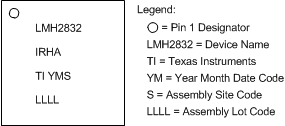ZHCSF77A July 2016 – July 2016 LMH2832
PRODUCTION DATA.
- 1 特性
- 2 应用
- 3 说明
- 4 修订历史记录
- 5 Device Comparison Table
- 6 Pin Configuration and Functions
- 7 Specifications
- 8 Parameter Measurement Information
- 9 Detailed Description
- 10Application and Implementation
- 11Power Supply Recommendations
- 12Layout
- 13器件和文档支持
- 14机械、封装和可订购信息
13 器件和文档支持
13.1 器件支持
13.1.1 器件命名规则
 Figure 64. 器件标识信息
Figure 64. 器件标识信息
13.2 文档支持
13.2.1 相关文档
相关文档请参见以下部分:
- 数据表《ADS54J40 双通道 14 位 1.0GSPS 模数转换器》(文献编号:SBAS714)
- 数据表《LMH3401 7GHz 超宽带、固定增益、全差分放大器》(文献编号:SBOS695)
- 数据表《LMH5401 8GHz 低噪声、低功耗、全差分放大器》(文献编号:SBOS710)
- 数据表《LMH6521 高性能双路 DVGA》(文献编号:SNOSB47)
- 数据表《LMH3404 双通道 7GHz 低噪声、低功耗全差分放大器》(文献编号:SBOS739)
- 数据表《LMH3402 双路可选增益 7GHz 低噪声、低功耗全差分放大器》(文献编号:SBOS744)
- 用户指南《LMH2832EVM-50 评估模块》(文献编号:SLOU454)
- 用户指南《LMH2832EVM-75 评估模块》(文献编号:SLOU438)
- 《LMH2832 TINA-TI 参考设计》(文献编号:SBOMA21)
- 《LMH2832 TINA-TI Spice 模型》(文献编号:SBOMA22)
13.3 接收文档更新通知
如需接收文档更新通知,请访问 www.ti.com.cn 网站上的器件产品文件夹。点击右上角的提醒我 (Alert me) 注册后,即可每周定期收到已更改的产品信息。有关更改的详细信息,请查阅已修订文档中包含的修订历史记录。
13.4 社区资源
The following links connect to TI community resources. Linked contents are provided "AS IS" by the respective contributors. They do not constitute TI specifications and do not necessarily reflect TI's views; see TI's Terms of Use.
-
TI E2E™ Online Community TI's Engineer-to-Engineer (E2E) Community. Created to foster collaboration among engineers. At e2e.ti.com, you can ask questions, share knowledge, explore ideas and help solve problems with fellow engineers.
-
Design Support TI's Design Support Quickly find helpful E2E forums along with design support tools and contact information for technical support.
13.5 商标
E2E is a trademark of Texas Instruments.
Keysight Technologies is a trademark of Keysight Technologies.
SPI is a trademark of Motorola Mobility LLC.
All other trademarks are the property of their respective owners.
13.6 静电放电警告

ESD 可能会损坏该集成电路。德州仪器 (TI) 建议通过适当的预防措施处理所有集成电路。如果不遵守正确的处理措施和安装程序 , 可能会损坏集成电路。
ESD 的损坏小至导致微小的性能降级 , 大至整个器件故障。 精密的集成电路可能更容易受到损坏 , 这是因为非常细微的参数更改都可能会导致器件与其发布的规格不相符。
13.7 Glossary
SLYZ022 — TI Glossary.
This glossary lists and explains terms, acronyms, and definitions.